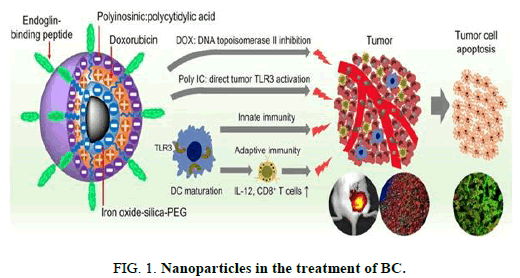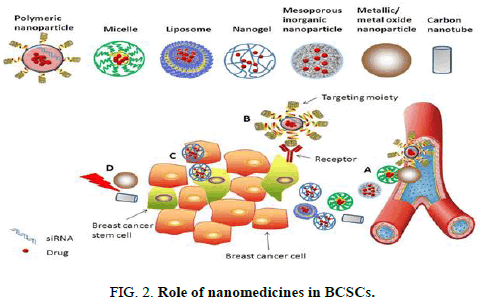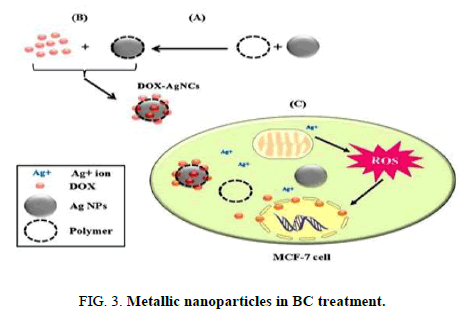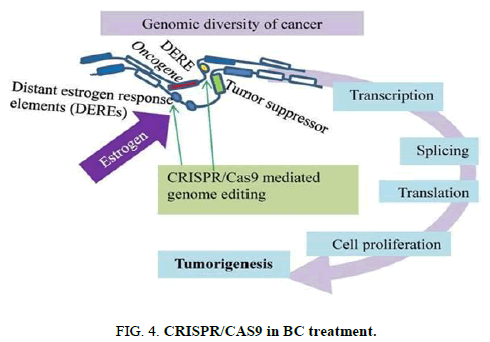Research
, Volume: 19( 1)Novel Technique-To Treat Breast Cancer
- *Correspondence:
- Waleed Bashir
Department of Osteopathic Medicine, Institute of Technology College of Osteopathic Medicine, New York, United States
Tel: 3328612939
E-mail: wbashir@nyit.edu
Received: December 26, 2022, Manuscript No. TSBT-22-84648; Editor assigned: December 28, 2022, PreQC No. TSBT-22-84648 (PQ); Reviewed: January 11, 2023, QC No. TSBT-22-84648; Revised: February 27, 2023, Manuscript No. TSBT-22-84648 (R); Published: March 08, 2023, DOI: 10.37532/0974-7435.23.19(1).001
Citation: Bashir W. Novel Technique-To Treat Breast Cancer. Biotechnol Ind J. 2023;19(1):001.
Abstract
Breast cancer is becoming more common in the world, resulting in a worse quality of life. Breast cancer affects between 2 and 2.5 million women worldwide annually. Early diagnosis and treatment of BC are necessary to suppress the progression of the disease. In this paper, we discuss nanoparticle based techniques for breast cancer treatment. Nanotechnology has several distinct advantages including active and passive targeting, miniature size (nanometric), the ability to connect several targeting moieties, site specific targeting and controlled release. Several chemotherapeutic agents with excellent responses in the treatment of BC have been delivered using nanocarriers such as metallic/inorganic NPs, polymeric nanoparticles/micelles, lipid based NPs, etc. This review covers new treatment techniques, clinical insights, and novel therapeutic approaches such as nanotechnology and nanomedicines for the treatment of BC.
Keywords
Progression; Breast cancer; Nanotechnology; Nanometric; Treatment
Introduction
Breast Cancer (BC) is a common and relatively frequent malignancy that affects between 2 and 2.5 million women worldwide annually. When exposed to carcinogenic substances, this form of malignancy frequently begins as ductal hyper proliferation and develops into metastatic carcinomas and benign tumors. In 2018, it was predicted that 627,000 women worldwide died from breast cancer. In the United States, invasive breast cancer strikes one in eight women at some point in their lives. According to projections, 280,000 additional instances of breast cancer will be discovered in the United States in 2022. According to WHO estimates, BC affects over 170,000 women in India, which is 14% more than the country’s overall cancer incidence rate [1].
The course, occurrence, response to therapy and even the site of metastases of this illness vary widely, in addition to its high degree of variability. Metastatic BC often affects several organs, including the lung, brain, and maybe bones. According to the World Health Organization (WHO), BC is the second most common cause of mortality for women globally. According to the WHO, 2.3 million women had been diagnosed with BC in 2020 and 685,000 women died from the condition globally [2].
The term “Triple Negative Breast Cancer” (TNBC) refers to almost 20% of breast tumors that do not express HER-2, ER or PR. TNBC shares (about 75%) basal like traits with an aggressive phenotype and a higher risk of metastasis. Multiple tumor suppressor genes’ altered genes and genomic instability may be to blame for the increased metastatic rate.
Progesterone Receptor (PR), Estrogen Receptor (ER) and/or Epidermal growth factor receptor 2 (ERBB2) gene mutation increase in the expression of BC are categorized into three primary tumor subtypes. There are treatments and different risk factors available for each form of cancer. Finding the tumor subtype, patient preferred therapy and cancer stage is a key step for optimum therapy [3-5]. The findings of the hormone receptor and ERBB2 tests will determine whether systemic medication should be given to nonmetastatic BC patients. To deal with these problems the use of nanoparticles is a promising strategy to treat cancer diseases like breast cancer. It may change the coatings of prosthetics to encourage cell growth, taken to mitigate and create undesirable consequences (Figure 1).
Materials and Methods
Nanomedicine mediated therapies to target breast cancer stem cells
Nanotechnology provides several ways for monitoring, diagnosing, imaging and administering chemotherapeutic medicines to tumor sites. Nanoparticles aid in the delivery of medications with less toxicity and increased efficacy and also aid in the cross enhancing anticancer action and biological barriers. Molecular biology, medicine, engineering, material science, pharmaceutics, and information technology are all combined in nanomedicine [6]. The use of nanoscience in medicine allows for a better understanding of the biological system and the numerous mechanisms involved. Nanocarriers may readily traverse cell membranes and other obstacles, allowing for greater medication penetration and delivery [7-9].
One of the most significant elements to consider for clinical use is biocompatibility, stability and circulation duration, all of which may be efficiently adopted by using nanomedicine. Nanomedicine, such as liposomes, dendrimers, drug loaded NPs and micelles have particular properties that allow them to permeate biological membranes and transport the entrapped medication into cells. Shape, surface chemistry and particle are characteristics that influence biodistribution, clearance processes and cellular uptake (Figure 2) [10].
Results and Discussion
Nanoparticles for the treatment of breast cancer
Recent advancements in nanoparticles imply that they can be employed for selective medication targeting in BC without harming tissues and healthy cells. NPs have distinguishing qualities such as biocompatibility, low toxicity, high encapsulation efficiency, and simplicity in production. NPs have the benefit of shielding the medication or encapsulated molecules from contact with an external environment, protecting the drug itself and avoiding contact with neighboring cells. Docetaxel-PGMA-PAA-nanoparticles were created by Sorolla, et al. and coupled with the peptides (EN1-RGD-iPep) to target ENGRAILED 1 (EN1), which is overexpressed in TNBC. The results showed that employing the peptide functionalized NPs decreased cell proliferation and increased apoptosis. Additionally, the 20 mg/kg dosage of DTX included in NPS was decreased to 2 mg/kg. It has been observed that the peptide attached NPs decreased tumor volume, increased anti-tumoral activity, and improved pharmacokinetics and bioavailability [11-13].
Traditional treatments for cancer, including prostate, ovarian and breast cancer, include gemcitabine and bevacizumab. The use of albumin Nanoparticles (NPs) in association with rapamycin for the therapy of recurrent breast cancer led to higher patient survival rates of up to 5 years. Inhibition of the mTOR pathway was followed by the main mechanism for the regression of tumor development.
Metallic nanoparticles: The metal based NPs offer excellent flexibility in diagnostic application, medication delivery and polymeric NPs. Gold nanoparticles loaded with DOX were created by Sun, et al. to more efficiently treat cancer by delivering the medicine to BCSCs. The work involves the rational design of DOX tethered gold NPs with PEG and an acid labile hydrazine bond, which has a larger capacity to transport DOX to BCSCs and reduce cancer initiation activity. After comparison between the control group and the group that received only free DOX, this nanocarrier displayed tumor volume reductions of 32 and 18 times, respectively. Another research found that the drug Chloroquine (CQ) increased the effectiveness of chemotherapeutic treatments against MDA-MB-231 cells in vitro and demonstrated nanoparticle mediated autophagy suppression. Gloriosa Superba Tuber Extract (GSTE) was used by Rokade, et al. to create photogenic Platinum Nanoparticles (PtNPs) and Palladium Nanoparticles (PdNPs). In vitro testing of the generated NPs against MCF-7 cells showed strong cytotoxicity. According to Ghosh, et al. GSTE was used to create gold (AuNPs) and Silver Nanoparticles (AgNPs). AgNPs and AuNPs both showed increased cytotoxicity against MCF-7 cells [14-16].
Polymeric nanoparticles and polymeric micelles: A notable benefit of polymeric nanoparticles is their biocompatibility. Decitabine (DAC), a DNA hypermethylation inhibitor, was encapsulated in PEG-NPs by Li, et al. which improved the response to assisted BCSCs, chemotherapy and MDA-MB-231 cells in overcoming drug resistance. PTX and salinomycin were delivered synergistically into the BCSCs using poly (d, L-lactide-co-glycolide)/hyaluronic acid based self-assembled block copolymer nanocarriers. Hyaluronic acid showed increased in vitro activity and enhances drug absorption by CD44+ receptors. Similar systems that contain Sulforaphane (SFN), a catenin inhibitor, decrease BCSCs’ capacity to self-renew [17].
By using photodynamic action, the multifunctional core shell nanomedicine can limit the spread of malignancies while increasing cytotoxicity.
Polymer micelles were created by Peto, et al. to shield the medication from phagocyte aggregation and degradation. The synthetic PTX micelles (Genexol-PM) showed enhanced therapeutic results when used to treat metastatic BC. Guo, et al. used methoxyl poly(ethylene glycol)-poly (d, L-lactide) copolymer micelles to study the effects of Resveratrol (RES) and DTX in combination on MCF-7 cells. The administration of both drugs at the same time demonstrated possible synergistic action in breast cancer cells (Figure 3).
Liposomes: Liposomes are spherical closed particles consisting of a liquid internal part and a permeable basal lamina. Gregoriadis, et al. published the first study on the utilization of liposomes in 1971. Hydrophobic medications can be contained in the lipid bilayer of liposomes, which are generally 50 nm-100 nm in size, whereas hydrophilic genes pharmaceuticals and siRNA (small interfering RNA) can be contained in the aqueous core. Longer circulation times, reduced systemic toxicity, biocompatibility and a low incidence of identification and subsequent clearance by the reticuloendothelial system are benefits of liposomes [18].
Inorganic nanoparticles: A combination of drugs is largely intended for cancer patients due to cancerous cells growth of treatment responses. To get over this drawback of conventional delivery vehicles, Mesoporous Silica Nanoparticles (MSNs) are exploited as a developing nanocarrier. According to a study by Meng, et al. MSNs co-administering DOX and siRNA reduced tumor development in vivo noticeably and had synergistic effects in comparison to siRNA therapy alone and naive drug. Due to the limited pore size distribution, the MSNs exhibit effective intracellular protection. By altering the surface of siRNA, the adsorption and release of siRNA may be changed. Several targeting options increased treatment effectiveness and improved tumor regression was seen in the in vivo tests performed on mice containing TNBC cells. Silica NPs are employed for both medication administration and tumor imaging.
Dendrimers: Dendrimers seem to be of significance as nanocarrier based technologies in cancer chemotherapy, particularly through ligand or receptor mediated endocytosis, since they provide various advantages over standard treatment by providing targeted features. Dendrimers exhibit a well-defined, symmetric and high specific surface area high branching nanoscale symmetrical structure with dimensions between 2 nanometers to 10 nanometers. Because of their unique properties, they are ideal carriers for the targeted administration of medical and analytical chemicals.
Lipid based drug delivery: According to certain hypotheses, lipid based nanoparticles may increase medication administration, minimize side effects, tumor tissue and help in the reversing of resistant strains. Different types of materials may be used to create lipid based colloids, which have a variety of diagnostics and therapeutic uses in the study of cancer. When constructed as Nanostructured Lipid Carriers (NLCs), Self-Micro/Nano Emulsified Drug Delivery Systems (SMEDDS/SNEDDS), SLNs, etc. they provide benefits including biodegradability, biocompatibility and targeting. In solid lipid nanoparticles combining tamoxifen citrate and capecitabine, the efficacy against MCF 10-A MCF-7 cells was increased. The toxic effect, biocompatibility and SLN persistence were all higher as compared to the single drug. The SK-OV3 and MCF-7 cell lines, as well as their multi drug resistance versions, have also been reported to be targets of NLCs encapsulating DOX and PTX.
Nucleic acid based therapeutics: Nanocarriers enable the transport of a variety of therapeutic compounds, especially nucleotides. The delivery method for nucleotides has shown promising results over the past 20 years and has generated a lot of attention as a potential strategy to treat illnesses. Rolling Circle Amplification (RCA) is one of the therapeutic nucleic acid isothermal amplification strategies that have been developed to target cancer cells. Nucleic acids can frequently be chemically altered by the insertion of functional groups or by the efficient fusion with nano sized entities that have been accurately separated at the atomic level. Advances in tumor targeted treatment are possible thanks to nucleic acid based nanomaterials distinctive chemical and physical properties.
CRISPR nanoparticles: The use of Liposomes based Hydrogel Nanoparticles (LHNPs), unique core shell nanostructures created to carry the nucleic acids and Cas9 proteins was described by Chen, et al. LHNPs deliver CRISPR/Cas9 with more efficiency in cell culture when combined with the minicircle DNA technology than commercially available lipofectamine 2000, and they may be used to suppress genes in malignancies. This shows that LHNPareis a flexible way of delivering CRISPR in cancer gene therapy applications, both research and medicinal [19].
To overcome the limited transfection capacity of CRISPR/Cas9, Zhang, et al. created PEG Phospholipids modified cationic Lipid Nanoparticles (PLNP). It produces a core shell component (PLNP/DNA) by encasing the Cas9/sgRNA plasmid and enables efficient transfection of the Cas9/sgPLK-1 plasmid into cancer cells. Polo Like Kinase-1 (PLK-1) protein was significantly suppressed when Cas9/sgPLK-1 plasmid was injected into mice, which led to a decline in tumor development. This method provides a versatile strategy that may be used to deploy the CRISPR/Cas9 system more effectively in both in vitro and in vivo (Figure 4).
Natural agent based nano-carriers: One of the primary sources for the creation of anti-cancer medications is natural ingredients. Plant derived phytochemicals can prevent carcinogenesis. Many bioactive natural substances may limit metastasis by obstructing different signaling pathways, which may play a significant role in medication development. As a result of their interactions with diverse proteins and enzymes, NPs have biological activity at the particular target of the broad chemical space.
By triggering cell cycle arrest, inhibiting angiogenesis, activating p53 and inducing apoptosis, phenolic substances, including flavonoids, lignins, tannins and coumarins, display anticancer action.
In MCF-7 human BC cells, quercetin loaded nanoliposomes showed improved solubility, bioavailability and cellular absorption. By triggering apoptosis, the tamoxifen and quercetin combination, when encapsulated in PLGA polymeric NPs and given orally, inhibited the development of breast cancers. When utilized to treat BC, quercetin loaded PLA NPs showed a significant decrease.
Conclusion
Nanomedicine contributes to significant advancements in the detection and treatment of breast cancer. Nanoparticle based technologies have progressed and are now playing an essential role in disease therapy. Nanomedicines have altered and customized both the diagnosis and treatment of breast cancer. NPs that combine therapeutic chemical, biological localization and diagnostic properties have been developed as next generation BC and TNBC therapies. Several chemotherapeutic agents with excellent responses in the treatment of BC have been delivered using nanocarriers such as metallic/inorganic NPs, polymeric nanoparticles/micelles and lipid based NPs (Liposomes, Solid Nanoparticles (SLNs) and Nanostructured Lipid Carriers (NLCs), among others. To boost targeting efficiency, NPs are coupled with mAbs or cell signaling pathway inhibitors. Greater knowledge of biological processes and nanotechnology advancements will undoubtedly aid in the development of more suitable nanomedicine for the treatment of breast cancer and TNBC in the future.
References
- Acevedo-Morantes CY, Acevedo-Morantes MT, Suleiman-Rosado D, et al. Evaluation of the cytotoxic effect of camptothecin solid lipid nanoparticles on MCF7 cells. Drug Deliv. 2013;20(8):338-348.
[Crossref] [Google Scholar] [PubMed]
- Alshareeda AT, Khatijah MN, Al-Sowayan BS. Nanotechnology: A revolutionary approach to prevent breast cancer recurrence. Asian J Surg. 2023;46(1):13-17.
[Crossref] [Google Scholar] [PubMed]
- Anantharaju PG, Gowda PC, Vimalambike MG, et al. An overview of the role of dietary phenolics for the treatment of cancers. Nutr J. 2016;15(1):99.
[Crossref] [Google Scholar] [PubMed]
- Bishayee A, Sethi G. Bioactive natural products in cancer prevention and therapy: Progress and promise. Semin Cancer Biol. 2016;40:1-3.
[Crossref] [Google Scholar] [PubMed]
- Chalakur-Ramireddy NK, Pakala SB. Combined drug therapeutic strategies for the effective treatment of triple negative breast cancer. Biosci Rep. 2018;38(1):20171357.
[Crossref] [Google Scholar] [PubMed]
- Chen Z, Liu F, Chen Y, et al. Targeted delivery of CRISPR/Cas9 mediated cancer gene therapy via liposome templated hydrogel nanoparticles. Adv Funct Mater. 2017;27(46):1703036.
[Crossref] [Google Scholar] [PubMed]
- de Santis CE, Fedewa SA, Goding Sauer A, et al. Breast cancer statistics, 2015: Convergence of incidence rates between black and white women. CA Cancer J Clin. 2015;66(1):31-42.
[Crossref] [Google Scholar] [PubMed]
- Feng C, Wang T, Zhang Y, et al. Novel surviving targeted small interfering RNA delivered by nanoparticles. Am J Med Sci. 2017;354(5):506-512.
[Crossref] [Google Scholar] [PubMed]
- Fenn KM, Kalinsky K. Sacituzumab govitecan: Antibody drug conjugate in triple negative breast cancer and other solid tumors. Drugs Today. 2019;55(9):575-585.
[Crossref] [Google Scholar] [PubMed]
- Fontana G, Maniscalco L, Schillaci D, et al. Solid lipid nanoparticles containing tamoxifen characterization and in vitro antitumoral activity. Drug Deliv. 2005;12(6):385-392.
[Crossref] [Google Scholar] [PubMed]
- Gililland JM, Anderson LA, Erickson J, et al. Mean 5 years clinical and radiographic outcomes of cement less total hip arthroplasty in patients under the age of 30. Biomed Res Int. 2013;2013:649506.
[Crossref] [Google Scholar] [PubMed]
- Gu J, Fang X, Hao J, et al. Reversal of P-glycoprotein mediated multidrug resistance by CD44 antibody targeted nanocomplexes for short hairpin RNA encoding plasmid DNA delivery. Biomat. 2015;45:99-114.
[Crossref] [Google Scholar] [PubMed]
- Guo X, Zhao Z, Chen D, et al. Co-delivery of resveratrol and docetaxel via polymeric micelles to improve the treatment of drug resistant tumors. Asian J Pharm Sci. 2019;14(1):78-85.
[Crossref] [Google Scholar] [PubMed]
- Han M, Lv Q, Tang XJ, et al. Overcoming drug resistance of MCF-7/ADR cells by altering the intracellular distribution of doxorubicin via MVP knockdown with a novel siRNA polyamidoamine hyaluronic acid complex. J Control Release. 2012;163(2):136-144.
[Crossref] [Google Scholar] [PubMed]
- Hsieh YS, Yang SF, Sethi G, et al. Natural bioactives in cancer treatment and prevention. Biomed Res Int. 2015;2015:182835.
[Crossref] [Google Scholar] [PubMed]
- Jain AK, Thanki K, Jain S. Co-encapsulation of tamoxifen and quercetin in polymeric nanoparticles: Implications on oral bioavailability, antitumor efficacy and drug induced toxicity. Mol Pharm. 2013;10(9):3459-3474.
[Crossref] [Google Scholar] [PubMed]
- Kachnic LA, Powell SN. IMRT for breast cancer balancing outcomes, patient selection and resource utilization. J Natl Cancer Inst. 2011;103(10):777-779.
[Crossref] [Google Scholar] [PubMed]
- Liu SQ, Ma XB, Song WM, et al. Using a risk model for probability of cancer in pulmonary nodules. Thorac Cancer. 2021;12(12):1881-1889.
[Crossref] [Google Scholar] [PubMed]
- Mahdavi M, Nassiri M, Kooshyar MM, et al. Hereditary breast cancer; genetic penetrance and current status with BRCA. J Cell Physiol. 234(5):5741-5750.
[Crossref] [Google Scholar] [PubMed]





